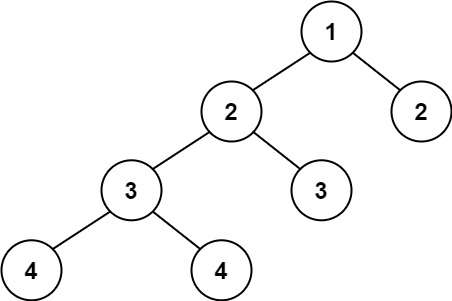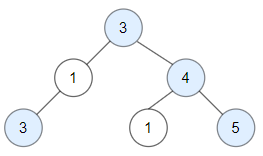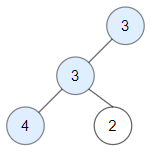Compare commits
No commits in common. "728a3f0c82761368519e7fef4f473a45dbb9aab5" and "fdc24da4fff03786577b15afeeb7b4c8e55f2bb1" have entirely different histories.
728a3f0c82
...
fdc24da4ff
@ -1,32 +0,0 @@
|
|||||||
Given a binary tree, determine if it is height-balanced.
|
|
||||||
|
|
||||||
For this problem, a height-balanced binary tree is defined as:
|
|
||||||
|
|
||||||
> a binary tree in which the left and right subtrees of _every_ node differ in height by no more than 1.
|
|
||||||
|
|
||||||
**Example 1:**
|
|
||||||
|
|
||||||

|
|
||||||
|
|
||||||
Input: root = [3,9,20,null,null,15,7]
|
|
||||||
Output: true
|
|
||||||
|
|
||||||
|
|
||||||
**Example 2:**
|
|
||||||
|
|
||||||

|
|
||||||
|
|
||||||
Input: root = [1,2,2,3,3,null,null,4,4]
|
|
||||||
Output: false
|
|
||||||
|
|
||||||
|
|
||||||
**Example 3:**
|
|
||||||
|
|
||||||
Input: root = []
|
|
||||||
Output: true
|
|
||||||
|
|
||||||
|
|
||||||
**Constraints:**
|
|
||||||
|
|
||||||
* The number of nodes in the tree is in the range `[0, 5000]`.
|
|
||||||
* `-104 <= Node.val <= 104`
|
|
||||||
@ -1,47 +0,0 @@
|
|||||||
# Time: O(N)
|
|
||||||
# Space: O(N)
|
|
||||||
|
|
||||||
# Definition for a binary tree node.
|
|
||||||
# class TreeNode:
|
|
||||||
# def __init__(self, val=0, left=None, right=None):
|
|
||||||
# self.val = val
|
|
||||||
# self.left = left
|
|
||||||
# self.right = right
|
|
||||||
from collections import namedtuple
|
|
||||||
|
|
||||||
class Solution:
|
|
||||||
def isBalanced(self, root: Optional[TreeNode]) -> bool:
|
|
||||||
Result = namedtuple('Result', 'is_balanced height')
|
|
||||||
|
|
||||||
def dfs(node):
|
|
||||||
"""
|
|
||||||
Instead of doing top-down, we'll do bottom-up recursion
|
|
||||||
via DFS to solve subproblems and bubble back up to the root
|
|
||||||
"""
|
|
||||||
|
|
||||||
# This happens when we reach leaf node, in which case, we assume
|
|
||||||
# things are balanced and return 0 height
|
|
||||||
if node is None: return Result(True, 0)
|
|
||||||
|
|
||||||
# DFS recursion
|
|
||||||
right = dfs(node.right)
|
|
||||||
left = dfs(node.left)
|
|
||||||
|
|
||||||
# For current `node`, things are only going to be balanced if
|
|
||||||
# both left and right subtrees are balanced. Otherwise, we can
|
|
||||||
# return False right away.
|
|
||||||
has_balanced_subtrees = right.is_balanced and left.is_balanced
|
|
||||||
|
|
||||||
# Besides having left and right subtrees themselves *individually*
|
|
||||||
# being balanced, we need to next check height difference <= 1.
|
|
||||||
if has_balanced_subtrees and abs(right.height - left.height) <= 1:
|
|
||||||
# Height of tree formed by current `node` would be the max
|
|
||||||
# height of its left/right subtree + 1 (itself)
|
|
||||||
return Result(True, 1 + max(left.height, right.height))
|
|
||||||
|
|
||||||
# If it reaches here, that means either height diff > 1 or left/right
|
|
||||||
# subtrees are already imbalanced.
|
|
||||||
return Result(False, 0)
|
|
||||||
|
|
||||||
|
|
||||||
return dfs(root).is_balanced
|
|
||||||
@ -1,34 +0,0 @@
|
|||||||
Given a binary tree `root`, a node _X_ in the tree is named **good** if in the path from root to _X_ there are no nodes with a value _greater than_ X.
|
|
||||||
|
|
||||||
Return the number of **good** nodes in the binary tree.
|
|
||||||
|
|
||||||
**Example 1:**
|
|
||||||
|
|
||||||
****
|
|
||||||
|
|
||||||
Input: root = [3,1,4,3,null,1,5]
|
|
||||||
Output: 4
|
|
||||||
Explanation: Nodes in blue are good.
|
|
||||||
Root Node (3) is always a good node.
|
|
||||||
Node 4 -> (3,4) is the maximum value in the path starting from the root.
|
|
||||||
Node 5 -> (3,4,5) is the maximum value in the path
|
|
||||||
Node 3 -> (3,1,3) is the maximum value in the path.
|
|
||||||
|
|
||||||
**Example 2:**
|
|
||||||
|
|
||||||
****
|
|
||||||
|
|
||||||
Input: root = [3,3,null,4,2]
|
|
||||||
Output: 3
|
|
||||||
Explanation: Node 2 -> (3, 3, 2) is not good, because "3" is higher than it.
|
|
||||||
|
|
||||||
**Example 3:**
|
|
||||||
|
|
||||||
Input: root = [1]
|
|
||||||
Output: 1
|
|
||||||
Explanation: Root is considered as good.
|
|
||||||
|
|
||||||
**Constraints:**
|
|
||||||
|
|
||||||
* The number of nodes in the binary tree is in the range `[1, 10^5]`.
|
|
||||||
* Each node's value is between `[-10^4, 10^4]`.
|
|
||||||
@ -1,37 +0,0 @@
|
|||||||
# Time: O(N)
|
|
||||||
# Space: O(N)
|
|
||||||
|
|
||||||
# Definition for a binary tree node.
|
|
||||||
# class TreeNode:
|
|
||||||
# def __init__(self, val=0, left=None, right=None):
|
|
||||||
# self.val = val
|
|
||||||
# self.left = left
|
|
||||||
# self.right = right
|
|
||||||
class Solution:
|
|
||||||
def goodNodes(self, root: TreeNode) -> int:
|
|
||||||
def dfs(node, max_value) -> int:
|
|
||||||
'''
|
|
||||||
Perform pre-order traversal and keep track of max
|
|
||||||
elements in the tree. Any subsequent traversal can
|
|
||||||
then compare against the updated max_value to see if
|
|
||||||
it's a good node or not
|
|
||||||
'''
|
|
||||||
|
|
||||||
# If no left/right nodes, then we can just return 0
|
|
||||||
if not node: return 0
|
|
||||||
|
|
||||||
# Current node is good if it's value is greater than or
|
|
||||||
# equal to the `max_value` seen so far
|
|
||||||
res = 1 if max_value <= node.val else 0
|
|
||||||
|
|
||||||
# Compute the new max value, the current node could be it
|
|
||||||
max_value = max(max_value, node.val)
|
|
||||||
|
|
||||||
# Do traversal on left and right nodes and add their units
|
|
||||||
res += dfs(node.left, max_value) + dfs(node.right, max_value)
|
|
||||||
|
|
||||||
# This will indicate the count
|
|
||||||
return res
|
|
||||||
|
|
||||||
|
|
||||||
return dfs(root, root.val)
|
|
||||||
Loading…
Reference in New Issue
Block a user